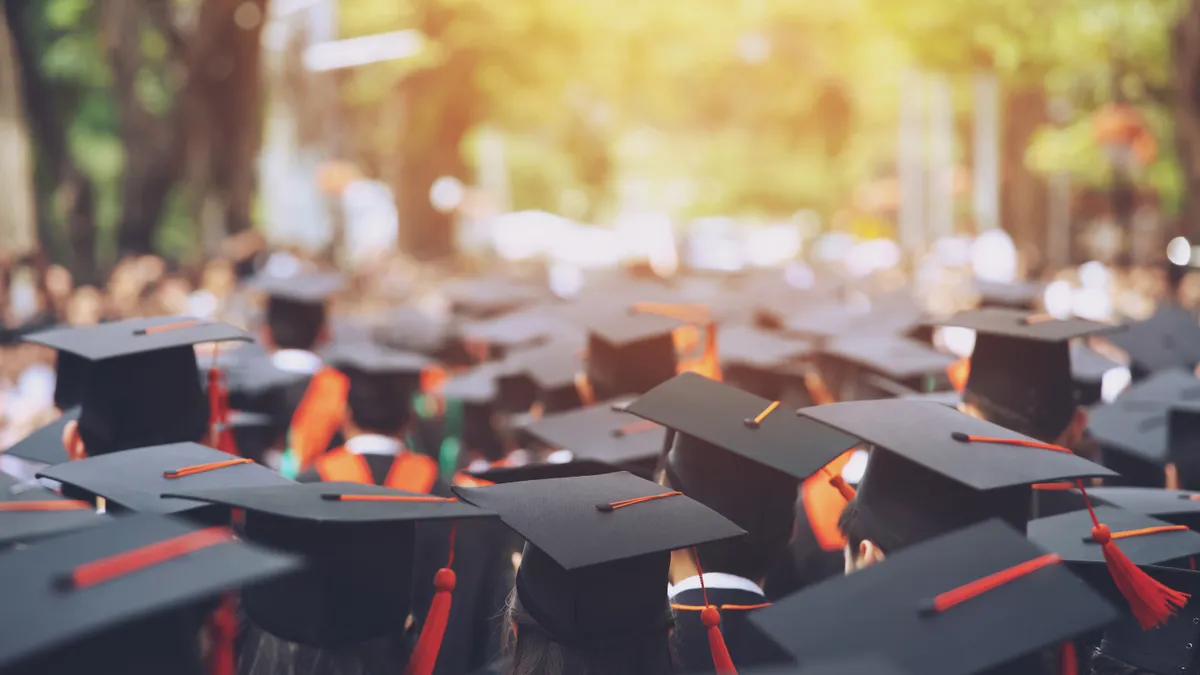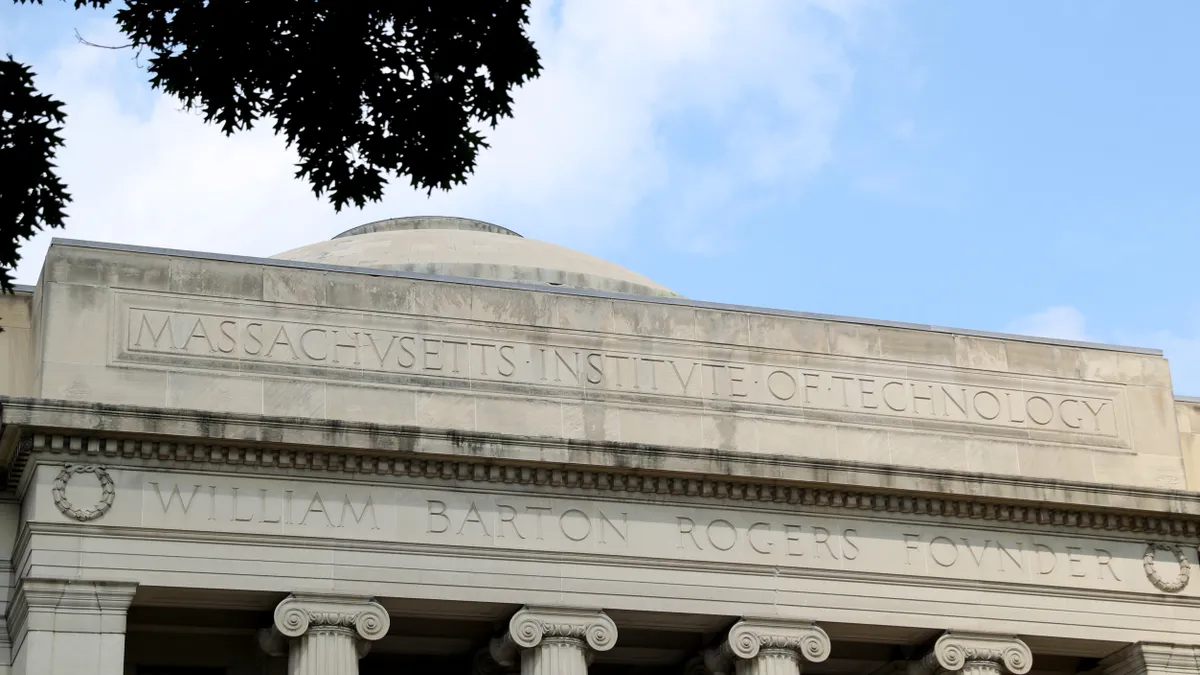The coronavirus pandemic is highlighting the vast social inequities in the U.S., and higher education has been no exception. Some students had nowhere else to go when campuses shuttered, or they lacked the space and technology to take classes from home.
Meanwhile, some institutions are struggling to survive, having to confront the incongruity between their need to stay open and desire to offer students equitable access to higher education.
Into this environment drops a new book called "The Merit Myth: How Our Colleges Favor the Rich and Divide America." Its authors, from the Georgetown University Center on Education and the Workforce (CEW), draw awareness to the inherent flaws in our country's higher education system — one they say "reserves the best opportunities mainly for those already on top."
Much of the growth in earnings gaps in the last few decades, the authors note, can be traced to differing access to and completion of quality college programs. Their blueprint for change includes relying less on standardized tests, dropping legacy admissions, requiring colleges to admit a certain share of low-income students and syncing K-12 and postsecondary learning.
Education Dive talked with one of the authors, Peter Schmidt, a veteran education journalist and senior fellow at CEW, about how students are accessing college and how to bridge secondary and postsecondary education.
This interview has been edited and condensed.
EDUCATION DIVE: The book explains that "instead of being havens of diversity ... many of our colleges and universities have become isolated communities, where students and faculty largely interact with those who are like them." To what kind of colleges and universities does that statement most commonly apply?
SCHMIDT: That statement applies to our selective colleges, and it becomes truer and truer the more selective the institution is. It also in some ways applies to higher education as a whole, and that we have low-income and minority students tracked into community colleges and less-selective or not-selective four-year institutions. But the isolation of people into groups of people just like them is most severe at the most selective institutions. One of my challenges to colleges that say they seek diversity is to consider how much exposure to diversity they seek among their own students. Because so many of their admissions considerations favor students who have been isolated from diversity on both a racial and class basis.
What is different about the institutions that don't fall into that group?
SCHMIDT: There are a lot of factors. There's mission, access to funding, the amount of money they're able to spend per student. There's absolutely the type of students they take in. The book has a lengthy discussion of how U.S. News and other ranking systems often put so much weight on the inputs of colleges as opposed to their outputs. You take kids from wealthy families who've been groomed for higher education their entire lives and of course they're going to graduate if you do anything at all to support them.
Many of these other schools are achieving a lot more that they don't get credit for because they're taking students who might arrive with less academic preparation, who have less support from home, who have been less groomed in the ways of academe.
Some research has suggested those schools can have strong outcomes for low-income students. I'm thinking of the findings from the Equality of Opportunity Project, which ranked colleges based on economic mobility. Most of the schools at the top of that list are regional public universities. What does that add to the tensions between the two tracks?
SCHMIDT: It doesn't really add to the tensions, it just points to a way out of them, or a way to resolve the tension between them. Those schools are very good at providing social mobility, which is sorely lacking in our society right now and is a big source of our problems. These universities do a good job of taking students from all backgrounds and getting them to graduation with degrees that will open up opportunities for them. They are the type of institution we need to be rewarding.
You and your co-authors write that the dual-tracking starts well before college admissions, arguing for bringing the K-12 and higher ed experiences together, particularly in the first two years of college. Can you explain how that might be achieved?
SCHMIDT: The K-14 framework is a recognition that we no longer live in a society where 12 years of school is enough to get by. Solid jobs for people who don't have any education beyond high school are a lot fewer and farther between, and most people get stuck in low-paid and insecure jobs. We're seeing that population especially hard hit now with the COVID crash. So the economic prospects are very precarious for people who don't have at least a few years of school.
That said, it's not quite correct to assume everybody needs a four-year degree. Georgetown CEW has done research documenting how some certificate or two-year programs can boost your long-term earnings prospects by teaching you a skill that's marketable. It's also possible to get a four-year degree in something that doesn't help you get a solid job.
Are years 13 and 14 a jumping off point for more higher education, or are they a way to ready students for the workforce?
SCHMIDT: It varies. If people are going to get a four-year degree, it should just be the first two years of a four-year program. If people are going to get just two more years of school, it should be some combination of preparation for specific employment, learning skills for the workplace. But we also advocate that liberal arts should no longer be seen as relegated to liberal arts programs in liberal arts colleges. We argue it's a mistake to think somebody who's getting one or two years of college beyond high school should just knuckle down and focus purely on skill training.
We're seeing more focus on short-term credentials tied to specific jobs, as well as employer-sponsored education programs. We're also seeing public university systems looking at how they can have more programs for nontraditional students. How do these types of programs fit in with the two tracks you and your co-authors point out?
SCHMIDT: The good news is that these programs are, in many cases, providing students with skills to land decent jobs. Being able to pay your bills is a very, very important thing in our society. And from that ability comes political empowerment and security and the ability to enjoy life. What I worry about is if the needs of employers dictate the extent of higher education opportunity — you know, many employers could probably care less if students are being taught to be politically empowered, to be good citizens, to think critically, to question authority, including potentially the employer's actions. There needs to be attention paid to learning that's independent of economic needs. The needs of employers are not the needs of human beings.
The book notes the "real value" of college programs in the labor market. How does the "real value" of a program like those compare to the value of a program at a highly selective university?
SCHMIDT: The answer to that is going to be really, really complicated. Certainly a highly selective institution that puts students on the track for an advanced degree is going to provide the kind of "gold standard" credentialing that's going to get them into high-paid employment. That's a different can of worms from schools that are grooming students for the middle class, which is fine, but there's less political power and a bit less job security there.
Elite colleges, often by doing much more than simply providing job skills, also give their graduates a lot more flexibility in a time of economic change and dislocation. There's a danger if a school is providing very, very job-specific training and nothing else. We're in an era where entire types of employment can disappear at the drop of a hat.
Is there anything else we should know about the book?
SCHMIDT: Right now, it's important to look at the book's discussion of how our society has been damaged by colleges', especially elite colleges', failure to look out for the greater good. We are experiencing a period of high-level polarization. It's important to look at the book as a whole and see the different parts that add up to the situation we're in now.


















